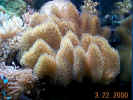 This Lobophytum sp. or rose leather coral is huge. This picture was taken
soon after the tank lights had turn on so she had not yet expanded to it's full
size. It expands to about 18" from end-to-end. I estimate that it weighs a
good 10 lbs, maybe more. I have had to move this coral several times to allow it
room to grow and keep it from over taking other corals. It was about the size of
a softball when I bought it around 2 years ago. I am planning to move everything
into a larger tank just to give this coral more room to grow.
This Lobophytum sp. or rose leather coral is huge. This picture was taken
soon after the tank lights had turn on so she had not yet expanded to it's full
size. It expands to about 18" from end-to-end. I estimate that it weighs a
good 10 lbs, maybe more. I have had to move this coral several times to allow it
room to grow and keep it from over taking other corals. It was about the size of
a softball when I bought it around 2 years ago. I am planning to move everything
into a larger tank just to give this coral more room to grow.
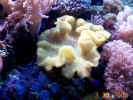 This
is a Sarcophyton sp., yellow leather coral. This is one of the tougher leather corals to
keep. Many believe this is because they do not ship well. This makes it
important to find a healthy specimen. Make sure it has good polyp extension in
the store. Place this coral under Metal Halide or Power Compacts. Make sure it
receives good water flow to keep detritus from collecting on the top. This coral
will feed on zooplankton.
This
is a Sarcophyton sp., yellow leather coral. This is one of the tougher leather corals to
keep. Many believe this is because they do not ship well. This makes it
important to find a healthy specimen. Make sure it has good polyp extension in
the store. Place this coral under Metal Halide or Power Compacts. Make sure it
receives good water flow to keep detritus from collecting on the top. This coral
will feed on zooplankton.
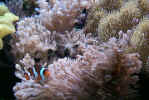 Xenia
elongata, a.k.a. reef weed, has almost taken over my tank. If it wasn't for
the frequent cuttings I make and trade, it would have overgrown most of it's
tank mates. Xenia is a very good
beginner coral provided you start with a healthy stalk, preferably one that was
tank raised. It does well under most lighting conditions and flow rates. This is
one of the only corals that are not believed to feed and receive all nutrients
from their symbiotic algae.
Xenia
elongata, a.k.a. reef weed, has almost taken over my tank. If it wasn't for
the frequent cuttings I make and trade, it would have overgrown most of it's
tank mates. Xenia is a very good
beginner coral provided you start with a healthy stalk, preferably one that was
tank raised. It does well under most lighting conditions and flow rates. This is
one of the only corals that are not believed to feed and receive all nutrients
from their symbiotic algae.
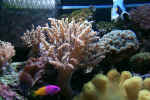 I've not been able to positively identify this Leather coral. I purchased it as
a cutting that was traded at a local fish store I frequent. It has nearly
tripled in size in a matter of 3 months. I have it placed near the top of the
reef where it is fully exposed to the Metal Halides. It does not seem to like
very much current and keeps it's polyps closed with a moderate flow rate. It
originally had a more green hue, but is now the "symbiotic" brown many
soft corals take on.
I've not been able to positively identify this Leather coral. I purchased it as
a cutting that was traded at a local fish store I frequent. It has nearly
tripled in size in a matter of 3 months. I have it placed near the top of the
reef where it is fully exposed to the Metal Halides. It does not seem to like
very much current and keeps it's polyps closed with a moderate flow rate. It
originally had a more green hue, but is now the "symbiotic" brown many
soft corals take on.
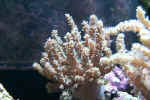 This is a cutting that I recently made of the finger coral above. I made it by
cutting a large branch off of the parent coral with a pair of scissors. I then
took a tooth pick and jabbed it through the base of the branch. I was then able
to rubber band the tooth pick, and cutting, to a rock. The coral attach to the
rock within about a week at which time, I removed the tooth pick. I hope to use
both corals for future propagation for trade with other hobbyists.
This is a cutting that I recently made of the finger coral above. I made it by
cutting a large branch off of the parent coral with a pair of scissors. I then
took a tooth pick and jabbed it through the base of the branch. I was then able
to rubber band the tooth pick, and cutting, to a rock. The coral attach to the
rock within about a week at which time, I removed the tooth pick. I hope to use
both corals for future propagation for trade with other hobbyists.
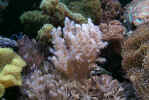 This Cladiella sp., commonly known as a Colt coral, is a very hardy coral if
aquarium conditions are right. It seems to prefer moderate light and current
conditions. This coral is actually a cutting from another hobbyist's reef. I
hope to make cuttings of my own to trade with other reef owners.
This Cladiella sp., commonly known as a Colt coral, is a very hardy coral if
aquarium conditions are right. It seems to prefer moderate light and current
conditions. This coral is actually a cutting from another hobbyist's reef. I
hope to make cuttings of my own to trade with other reef owners.
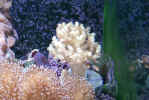 This is a cutting that I purchased at a LFS. Supposedly, it was aqua cultured in
Tonga. The LFS has no idea species name of this coral. I've had it for
about 1 month and it has already budded near the base. I am hoping this coral
will do well, so that I can propagate it.
This is a cutting that I purchased at a LFS. Supposedly, it was aqua cultured in
Tonga. The LFS has no idea species name of this coral. I've had it for
about 1 month and it has already budded near the base. I am hoping this coral
will do well, so that I can propagate it.

![]()